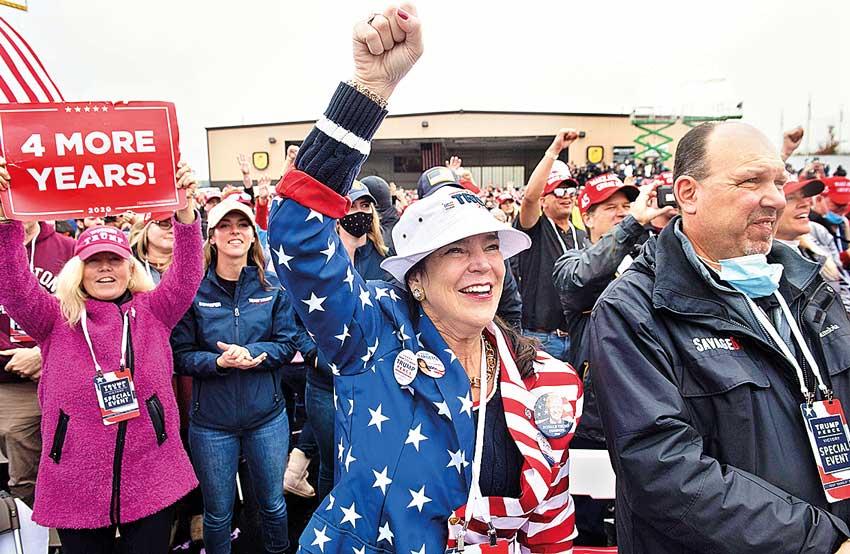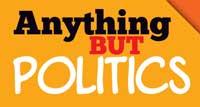
Supporters cheer as US President Donald Trump holds a Make America Great Again campaign rally at Lancaster Airport in Lititz, Pennsylvania, October 26, 2020 (AFP)
Growing concern over ecological issues, once only articulated by native communities, has seen the general public become more aware of native issues
According to her, there are over 500 “recognized” tribes and villages in the United States
Currently, many native communities now have active programmes of language and cultural retention
Amid the pandemic raging across the globe, the world is focused on the November 3 election which will determine who will rule the United States, the world’s largest economic power, for the next four years.
The US is such a diverse society with a multiple layers of people and communities wielding political power and presenting their respective cases. Lesser known to the outside world, particularly the countries that are so remote from the US is that it is still home to over 500 recognized tribes: some sequestered in far flung areas of that country, and the others well absorbed into metropolitan societies.
Shayne Del Cohen, editor of Journal to Indian Country, is a US academic who has done extensive work with the tribal communities. A holder of a doctorate in international law, she says her real education comes from her engagement with the indigenous communities which account for 2.4 percent of the total US population.
According to her, there are over 500 “recognized” tribes and villages in the United States, each with their own history, legacy, culture, economic and social status.
In States with small populations and large native communities, the same is true. In terms of national elections, the voting percentages probably do not impact the Electoral College outcome
“Thus there is no one answer, but one can point to an official US 1924 (Merriam) Report that stated if the conditions the day prevailed, there would be no more Indians by 1950. Twentieth Century history and tribe-US Government relations have a rich up/down narrative with the result that as of June, 2020, the American Indian and Alaska native population is estimated to reach 10 million people, or approximately 2.4 percent of the U.S. population,” she said.
Asserting that indigenous communities possess a reservoir of traditional knowledge, she said, “It is well documented that Native Americans have lived on the continent for at least 10,000 years thus developing an intimate relation with the land and ecology. When one is thus situated, one develops an intimate knowledge of the ecology, geology, flora and fauna. To survive - and thrive - these peoples knew how to use and sustain everything around them, evolving extensive practices of medicine, justice, child rearing, obtaining food/water/salt, fire suppression, housing, genetics, etc.”
Currently, many native communities now have active programmes of language and cultural retention.
“Unfortunately, through conscious native language suppression, much of the information has been lost or is partial. Many native communities now have active programs of language and cultural retention. Additionally, in areas that have been ‘settled or built up’ much of the natural flora and fauna have disappeared so much world knowledge has been lost,” she said.
The growth of the Indian gaming industry has positioned some tribes in almost dominant positions in their regions due to money in general, but also the employment and tourism impacts of their facilities
In the modern context, she said many native practices ironically had been adopted, often without recognition. She cited dual residences, seasonal migration, solar utilization, environmental conservation, spiritual practices are some examples. She said many pharmaceutical companies attempt to patent native use of plants.
It is interesting to note that many manufactured drugs have the same atomic makeup as medicinal plants.
All the components of “it takes a village” are re-emerging, from baby baskets, counseling and mentoring, to utilizing everything around you and recycling. Mankind, as an animal, has not evolved far from its origins in terms of basic needs and human characteristics.
Asked about their influence in American politics, she said, ““In the days of colonial America and through the 1880s, many emergent politicians earned their reputation and status as Indian fighters, or through acts and legislation of ‘getting rid of the Indian scourge’”.
Indians were not US citizens until 1924. Although the voting franchise is supposed to be part of citizenship, the right - and practice - was not equitably applied. The Voting Rights Act of 1965 clarified the issue for many, but since many elections are under State laws, there are still groups fighting for voting rights.
In local elections, depending on how district lines are drawn, the native community can swing an election for local officials.
In States with small populations and large native communities, the same is true. In terms of national elections, the voting percentages probably do not impact the Electoral College outcome. “Influence, however is another matter. Growing concern over ecological issues, once only articulated by native communities, has seen the general public become more aware of native issues and or their own,” Del
Cohen said.
The growth of the Indian gaming industry has positioned some tribes in almost dominant positions in their regions due to money in general, but also the employment and tourism impacts of their facilities.
According to Del Cohen, the participation within tribal elections is always “hot and heavy”. The National Congress of the American Indian sponsors “Native Vote”. The areas of focus for the Native Vote campaign are:
- Get-Out-The-Vote (GOTV) and registration efforts.
- Election and voter protection awareness and advocacy.
- Voter and candidate education.
- Tribal access to data.
“There are aggressive campaigns of voter registration and for voting at county, State and national elections. Many communities have been successful in establishing polling places within their territory, reducing the access issue. The pandemic, however, has compromised many situations and November 3 will tell the current tale,” she said.
Commenting on their expectations as far as the upcoming election is concerned, she said, “Each community has different/issues and expectations. As a general theme, however, tribal sovereignty is paramount whether it be at a national or state level. Thus native voters seek candidates, platforms, and legislation that understand their history and issues respect their input and supports their proposals for mitigation. With the current administration having abolished over 20 Executive Departments, each community must deal with the fallout of the tribal-US government relations that have evolved as a result. Many hope for restoration. One sees more and more Natives elected to public office at every level of government. All those candidates and the views they represent hope to be elected!
In the United States, the president is chosen by not by direct votes but by the Electoral College. It is a body comprising electors determined for each sate depending on its population size. The native communities are numerically large enough to send sufficient electors to the Electoral College.


